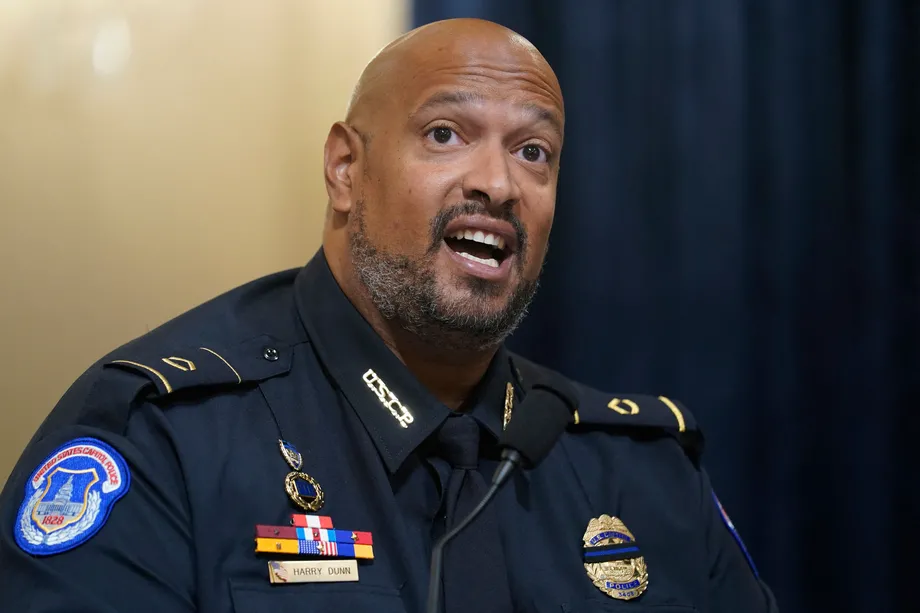First Time Being Called the ‘N-word’ in Uniform
AP Reveals Klan Cell in Fla. Corrections Dept.
How CBS Reporter Almost Lost His Voice
White Male Top Newsroom Leadership Declining
Bucks Are 80% Black, But What About the TV Team?
Lightfoot on Media Diversity: ‘I Want Results’
Data on Natives and COVID Are in a Black Hole
Move Past Whiteness in Covering Remote Learning
The Atlantic to Explore Myriad Ways to Be American
. . . There’s Also ‘Black Atlantic’ in Nigeria
Short Takes
Support Journal-ismsHomepage photo: Capitol Police Officer Harry Dunn testifies Tuesday. (Pool photo)
First Time Being Called the ‘N-word’ in Uniform
From the days of television cameras showing police dogs attacking civil rights protesters in the 1960s to the video recording of the police murder last year of George Floyd, media images have shaped the perception of racism in the United States.
Tuesday’s House committee hearing on the Jan. 6 insurrection might not rise to that level, but the televised testimony about the racial invective hurled at Black Capitol police should surely disabuse deniers of the notion that racism was not part of the equation for the Donald Trump-inspired mob.
“ ‘No one had ever ― ever ― called me a ‘n****r’ while wearing the uniform of a Capitol Police officer’ until Jan. 6, Capitol Officer Henry Dunn said during Tuesday testimony in front of House select committee members investigating the attack,” Sebastian Murdock reported for HuffPost. Dunn was first called that by a woman “in a pink MAGA shirt,” then by others as he strove to protect the Capitol.
Later, Officer Aquilino Gonell of the Capitol Police, who immigrated from the Dominican Republic and is a naturalized U.S. citizen and veteran of the Iraq war, said that at different points during the insurrection, rioters told him “you’re not an American” — a conclusion Gonell said they reached solely because of the color of his skin.
Mabinty Quarshie and Matthew Brown of USA Today added that Officer Daniel Hodges of the Metropolitan Police Department, who also testified, said that the mob was overwhelmingly white and male. Hodges, who is white, testified that he did not encounter any racial abuse that day; instead several rioters tried to recruit him.
“One came and said, ‘are you my brother?'” Hodges said as the white supremacists tried to enlist him.
“People who associate with Donald Trump seem more likely to subscribe to that belief system,” Hodges said.
Reporting on Dunn’s testimony, Politico’s Nick Niedzwiadek added about Dunn, “He said he was not alone in experiencing racist epithets during Jan. 6, and that in the aftermath of that day other officers shared similar stories of their confrontations with the pro-Trump mob.
“One officer told me he had never in his entire 40 years life being called a n—– to his face and that streak ended on January 6. Yet another Black officer later told me he had been confronted by insurrectionists in the Capitol who told him, ‘Put your gun down, and we’ll show you what kind of n—– you really are.’
One of the gripping and shocking moments today: Officer Dunn’s emotional account of rioters calling him the N word which he says he’d never heard before while wearing uniform of Capitol Police @MSNBC
— Andrea Mitchell (@mitchellreports) July 27, 2021
“Dunn said that after that word was used against him ‘the rest of the afternoon is a blur,’ but he and other officers are still living with the trauma they experienced. He said he has also sought counseling in the aftermath of that day, and encouraged other officers to do so as well.”
The officers’ testimony on the Jan. 6 events was so vivid that even Fox News, which carried the hearing live using the chyron “Dem-Led Committee Holds First Jan. 6 Hearing,” had to concede its power. Anchor Bret Baier told viewers it was “an eye opener for people who think [the insurrection] was not violent,” and a challenge for Republicans who predicted the hearing would be a partisan exercise and portrayed the insurrection as “not a big deal.”
On Wednesday, Fox host Tucker Carlson had told viewers, “Dunn will pretend to speak for the country’s law enforcement community, but it turns out Dunn has very little in common with your average cop, Dunn is an angry left-wing political activist.”
In Washington, MSNBC, CNN and CBS affiliate WUSA also showed the hearing live, while others were showing the Tokyo Olympics, and in the case of BET and TV One, the sitcoms “Martin” (BET) or “One on One” (TV One).
Joshua I. Eure, Black News Channel vice president of live programming said through a spokesperson, “BNC’s coverage of the House Select Committee’s first hearing into the insurrection kicked off on the Start Your Day with Sharon and Mike morning show. Our Washington, D.C. correspondent, Bofta Yimam, was live from the Rotunda of the Capitol starting at 6am ET. She delivered several live hits to the morning show. Our D.C. Today team anchored by Del Waters went into special coverage at 9:30am ET as the hearing was getting underway.
“BNC carried the hearing LIVE in its entirety. Afterwards, our BNC Live team revisited testimony from the four witnesses through the lens of racism; specifically, the racial slurs the insurrectionists shouted at officers. Our dayside correspondent, Rarione Maniece, reported from the Rotunda for the afternoon and early evening programs. BNC Live welcomed several panelists for deep dive discussions throughout the day, comparing the January 6th insurrection to Black Lives Matter protests. We also heard from Republican, Independent and Democrat strategists to dissect testimony.”
On CNN, anchor Jake Tapper played a clip of Dunn’s testimony about the N-word and said it was “difficult to listen to, to put yourself in his shoes,” yet “it’s important for us to hear it.”
Tapper then turned to his panel, which included African Americans Charles Ramsey, a former Washington and Philadelphia police chief, and legal analyst Laura Coates, an attorney.
Ramsey replied that “the entire episode is something that’s leaving some deep psychological wounds. I just hope they’re going to get some kind of help.”
An employee assistance program “isn’t designed to deal with the kind of trauma we’re dealing with here.” Ramsey said he had never been called the N-word to his face in his 47-year law-enforcement career.
Coates said, “I’ve been called the N-word on the air,” referring to her Sirius XM radio show. “It’s hurtful but never quite surprising.” She noted the assumption that Gonell was “the other” because of his darker skin, and that the mob treated Hodges differently because he is white.
If it were Black people storming the Capitol on January 6th, the walls would have been dripping in blood. Not only was it an attempted coup on our democracy, it was white supremacy in plain sight. We need answers and we demand justice. This is not a partisan issue.
— Derrick Johnson (@DerrickNAACP) July 27, 2021
Coates turned then to the philosophical question raised by Rep. Adam Schiff, D-Calif., who asked Dunn if he believed the attack reflected America.
Dunn said Black officers “believe we fought a different battle. I guess it is America,” he said. “It shouldn’t be, but I guess that’s the way that things are. … It’s not the side of America that I like. It’s not the side that any of us here represent. We represent the good side of America.”
Coates agreed that “I guess this is America.”
Terrance W. Gainer, from 2007 to 2014 the sergeant at arms of the U.S. Senate, said to Tapper that in totality, “I think this is the most powerful testimony I’ve heard in my years on the job.”
- David Bauder, Associated Press: Hearing exposes TV viewers to blunt language, racial slurs
- Stephen A. Crockett Jr., The Root: Blue Lives Matter? During Emotional Testimony, Officers Recall How MAGA Insurrectionists Almost Killed a Cop and Repeatedly Called Another the N-Word
- Howard Kurtz, Fox News: Police officers cut through gamesmanship with harrowing accounts of defending Capitol
- Victoria Moorwood, Revolt: Capitol Police Officer Harry Dunn recalls being called N-word by rioters during House hearing
- Aaron Morrison, Associated Press: Racism of rioters takes center stage in Jan. 6 hearing

AP Reveals Klan Cell in Fla. Corrections Dept.
“It was 11:30 a.m. on March 19, 2015, and the klansmen were celebrating what they thought was a successful murder in Florida,” Jason Dearen reported Tuesday for the Associated Press.
“But the FBI had gotten wind of the murder plot. A confidential informant had infiltrated the group, and his recordings provide a rare, detailed look at the inner workings of a modern klan cell and a domestic terrorism probe. The Associated Press has reconstructed the story of the failed murder plot.
“That investigation would unearth another secret: An unknown number of klansmen were working inside the Florida Department of Corrections, with significant power over inmates, Black and white. . . .”
Dearen also wrote, “Today, researchers believe that tens of thousands of Americans belong to groups identified with white supremacist extremism, the klan being just one. These groups’ efforts to infiltrate law enforcement have been documented repeatedly in recent years and called an ‘epidemic’ by legal scholars. . . .” [Added July 28]
- Associated Press: Telling the story of a KKK murder plot and FBI investigation
View this post on Instagram
How CBS Reporter Almost Lost His Voice
“I lost my voice, and frankly, I thought my career was over,” CBS correspondent Jeff Pegues revealed Monday in an Instagram interview with CBS News’ Jericka Duncan.
Pegues, CBS’ chief justice and homeland security correspondent, spoke publicly for the first time about his battle with his voice, the network reported.
“It’s like a second baseman in baseball who can’t throw to first,” Pegues said.
“Pegues, 51, revealed that he suffers from spasmodic dysphonia, a voice disorder that causes involuntary spasms in the muscles of the larynx. Also referred to as ‘[shaky’ voice,’ the disorder causes a person’s voice to break and have a tight, strained sound.
” ‘What happens is, when you talk your vocal cords push together creating the sound,’ Pegues said. ‘In my case, and in the case of others who have spasmodic dysphonia, the vocal cords don’t come together.’
“Working with specialists at Johns Hopkins Hospital in Baltimore, Pegues says he was told there was no cure for the disorder, and that it’s related to something in the brain.
” ‘I believe it started for me because I was feeling tremendous anxiety. About five years ago, I noticed my voice was getting weaker,’ he said. ‘It got to the point where it would take me 20 minutes or so to read a track.’
“Pegues began working with health experts to find a remedy, and recently tried Botox as a form of treatment. . . .”
CBS also wrote, ” ‘At the height of this problem, I would just freeze up because I didn’t know what was going to come out of my mouth,’ he revealed. ‘I would even decline radio interviews. I just didn’t feel comfortable. It was a real low point.’
“Asked why he chose to speak about the struggle now, Pegues said, ‘It’s something I’ve been working on and part of that is being honest with myself and with other people. If there’s something stressful in your life, you need to weed it out of your life.’ “
Pegues also said, “Don’t put too much pressure on yourself, take moments to break away and think about what’s really important for you. Be honest with yourself about your mental health, as well as your physical health. It’s all very important.”
White Male Top Newsroom Leadership Declining
“Of the 20 largest newspapers, only 7 are led by a white man. Twelve are led by a woman, a person of color, or both,” Joshua Benton wrote Monday for Nieman Lab. “(One top job, at the Honolulu Star-Advertiser, is vacant.)”
Benton also wrote, “By holding 7 of the 19 top jobs, white men make up 36.8% of these newsroom leaders. On its own, from a diversity standpoint, that’s…not terrible, actually! As of 2019, 62.9% of American adults were non-Hispanic whites, with white man making up a bit less than half of that share.
“So while 36% is an over-representation, it’s a relatively small over-representation — especially compared to not that long ago, when these jobs might have been 80-90% white men.”
This is a case where the word “Hispanic” might be differentiated from “Latino,” which usually means having roots in Latin America and with “people of color.”
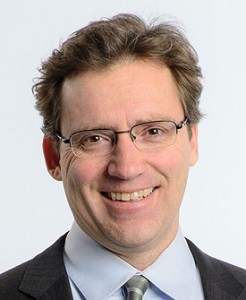 Rene Sanchez (pictured), editor and vice president of the Star Tribune in Minneapolis, messaged Journal-isms in 2008, “Actually, I’m a mix of Spanish, French, German and Irish. I grew up in New Orleans, and you can track my family’s lineage there all the way back to the early 1800s. The first Sanchez in my family line came from Spain, and the Sanchez’s afterward started marrying in the New Orleans melting pot of many different ethnicities …”
Rene Sanchez (pictured), editor and vice president of the Star Tribune in Minneapolis, messaged Journal-isms in 2008, “Actually, I’m a mix of Spanish, French, German and Irish. I grew up in New Orleans, and you can track my family’s lineage there all the way back to the early 1800s. The first Sanchez in my family line came from Spain, and the Sanchez’s afterward started marrying in the New Orleans melting pot of many different ethnicities …”
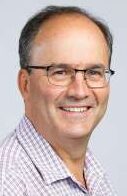 Emilio Garcia-Ruiz (pictured), editor in chief of the San Francisco Chronicle, likewise traces his lineage to Spain, rather than Latin America.
Emilio Garcia-Ruiz (pictured), editor in chief of the San Francisco Chronicle, likewise traces his lineage to Spain, rather than Latin America.
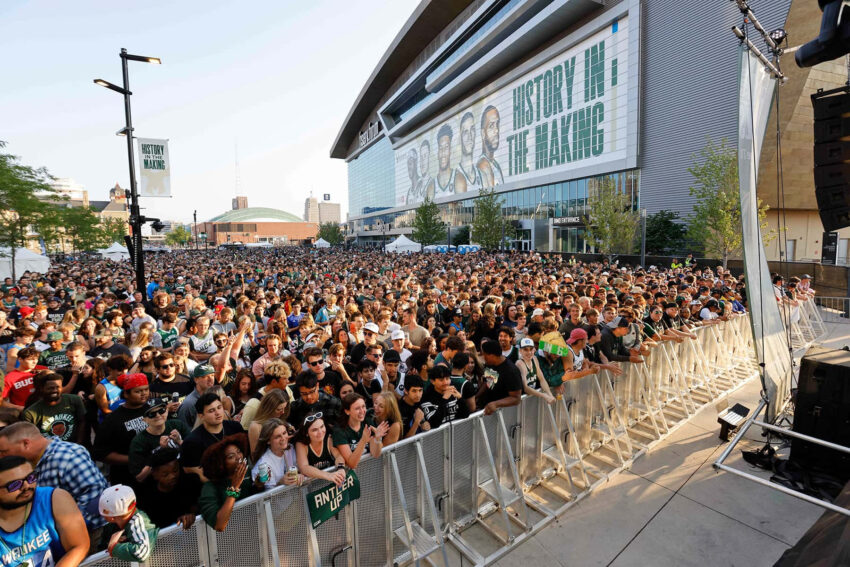
Bucks Are 80% Black, But What About the TV Team?
“As the city celebrated the win, TV stations in Milwaukee and across Wisconsin shared in the excitement through their coverage of Game 6 of the NBA Finals,” Earl Arms, president of the Wisconsin Black Media Association, wrote Wednesday in the Milwaukee Independent.
“For this reason, we, at the Wisconsin Black Media Association (WBMA), believe it is important to not only focus on what was happening on the basketball court, but to bring attention to who was not in the picture, as far as coverage of the historic game.
“Based on our observations and knowledge, it was evident that local coverage of the NBA Finals has not consistently reflected the diversity of the team or the viewing market. This stems largely from the fact that African Americans and other journalists of color remain woefully underrepresented in sports broadcasting locally and nationally, and the NBA Finals only perpetuates the problem.
“While all stations have had shortcomings when it comes to diversity, coverage by WISN 12 News is significant because it is the station in Milwaukee that broadcast the NBA Finals.
“For this reason, we at WBMA, believe that it is incumbent upon WISN 12 and other local news entities to hire and promote staff that reflect the community, so that stories being told are accurate and fair, in sports and all news coverage. This is vitally important in a majority-minority city such as Milwaukee, where 38% of its citizens are African American.
“What’s more, 80% of Bucks players are Black, which begs the question: can you truly guarantee accuracy in coverage when 0% of your on-air talent on any given day is Black and a small percentage of decision makers in your newsroom reportedly are Black? . . .”
Asked to respond, WISN News Director Matt Sinn messaged, “We welcome feedback and are always focused on how to improve our representation of the local community. We are proud of our coverage of the NBA Finals and WISN’s diverse news team.”
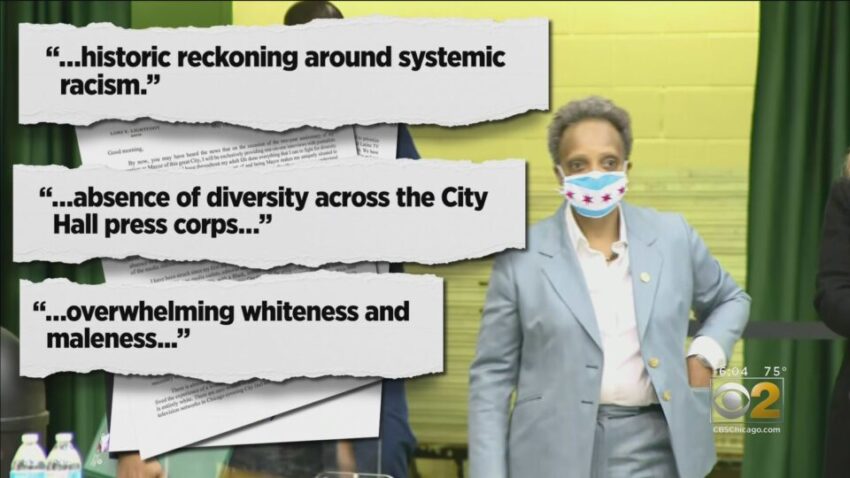
Lightfoot on Media Diversity: ‘I Want Results’
Chicago Mayor Lori Lightfoot continued to defend her decision to speak only with reporters of color for one day in May, calling the number of journalists of color covering her “unacceptable” and declaring she’d do it again because of the conversation it spurred.
“I would absolutely do it again. I’m unapologetic about it because it spurred a very important conversation, a conversation that needed to happen, that should have happened a long time ago,” Lightfoot told “Sway” host Kara Swisher in an interview published Monday in The New York Times (audio), Brian Flood reported for Fox News.
” ‘Here is the bottom line for me, to state the obvious, I’m a Black woman mayor. I’m the mayor of the third-largest city in the country, obviously I have a platform, and it’s important to me to advocate on things that I believe are important,’ Lightfoot said. ‘Going back to why I ran, to disrupt the status quo. The media is critically important to our democracy … the media is in a time of incredible upheaval and disruption but our City hall press corps looks like it’s 1950 or 1970.’
“Lightfoot said reporters who show up to cover her events are ‘invariably overwhelmingly White’ and urged media organizations to change their makeup.
” ‘People that make the hiring decisions have to be focused on diversity,’ she said. ‘In Chicago, we have a huge amount of diverse media talent. We’ve got schools that are of journalism that are best in class across the country, and I would say, really, across the world. So the absence of journalists of color, covering the mayor of the third-largest city in a country is absolutely unacceptable. And so I decided to say something about it.’
“Swisher agreed on diversity being an issue but objected to politicians choosing who is allowed to cover them.
” ‘I just taught at the University of Chicago. You have amazing diverse journalists studying there that I taught. And I agree with the need for more diversity in media. But politicians don’t get to choose who covers them,’ Swisher said.
” ‘No, it’s not about me choosing who covers me, right? I gave exclusive interviews. And we do get to choose who we talk to in exclusives. I gave exclusive interviews with journalists of color, right? One 24-hour period and it was like people’s heads exploded. I had journalists saying, ‘Does the mayor think I’m racist?’ No, it’s not about individuals,’ Lightfoot said. ‘It’s about systemic racism.’
“Lightfoot declared she was simply calling it like she sees it.
” ‘And challenging the heads of the media companies here in town to do a better job of bringing journalists of color, women into the fray. That’s what this is about,’ Lightfoot said. “And so, yeah, I could have been quiet and sat back and said, ‘Well, I don’t like this. I think they could do better,’ but kept it to myself. But why should I? If not me, who?’
“Swisher then asked if her controversial strategy of only granting exclusive interviews to non-White reporters has worked.
“I would absolutely do it again. I’m unapologetic about it because it spurred a very important conversation, a conversation that needed to happen, that should have happened a long time ago,’ Lightfoot said. ‘But I don’t want just a conversation. I want results. I want to see these networks, these companies, these producers, the decision makers take this seriously, because it’s a serious issue.’
“Swisher responded, ‘100 percent,’ and said she’s seen the same issue plague reporters who cover the tech community.
” ‘The media plays a very important role in our democracy. And if the only voices in the media are White guys, that’s a problem,’ Lightfoot said. . . .”
In addition, as Susy Schultz, executive director of Chicago’s Museum of Broadcast Communications, pointed out in May, women seem to have forgotten that their numbers increased in the 1930s when first lady Eleanor Roosevelt “insisted that only women cover her news conferences,” as Kay Mills reports in her “A Place in the News: From the Women’s Pages to the Front Page.”
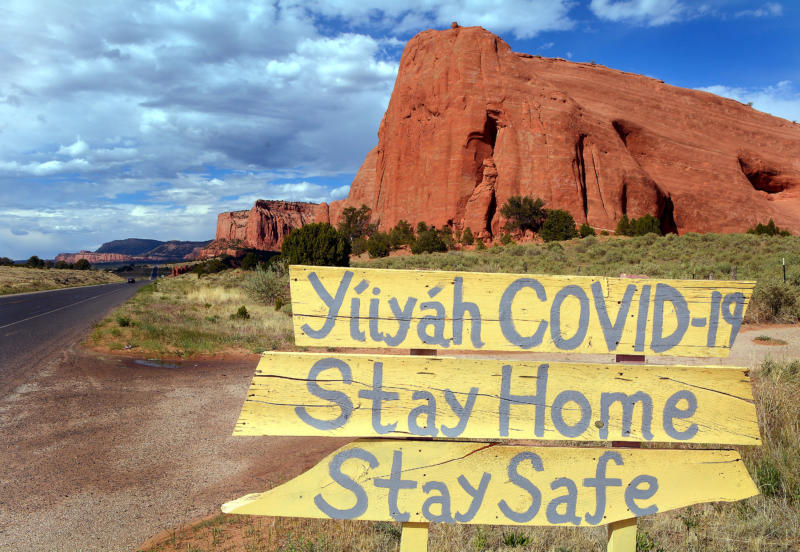
Data on Natives and COVID Are in a Black Hole
“We may never know how many American Indians or Alaska Natives died of COVID-19,” Tristan Ahtone wrote Friday for the Poynter Institute.
“The Indian Health Service, a division of the U.S. Department of Health and Human Services, is not keeping track. The Centers for Disease Control cannot tell us. And some state health authorities will not disclose that data, despite multiple public records requests, even though it would shed light on the pandemic’s death toll in Indian Country.
Ahtone also wrote, “Even if evidence suggests Indigenous communities have been among the hardest hit by COVID-19, no central system exists to measure the pandemic’s impact in Indian Country.
“Many tribes rely on state or federal authorities for data collection. A refusal by states to release such information, including death documents, not only violates the spirit of open records laws; it undermines trust in the transparency and accountability of all government agencies. It also further marginalizes and disenfranchises Indigenous nations and impedes journalists from doing their jobs.
“With tribal governments sometimes imposing their own restrictions on media freedom, Indigenous people are often left without access to important information from either their own nations as well as federal and state governments. . . .”
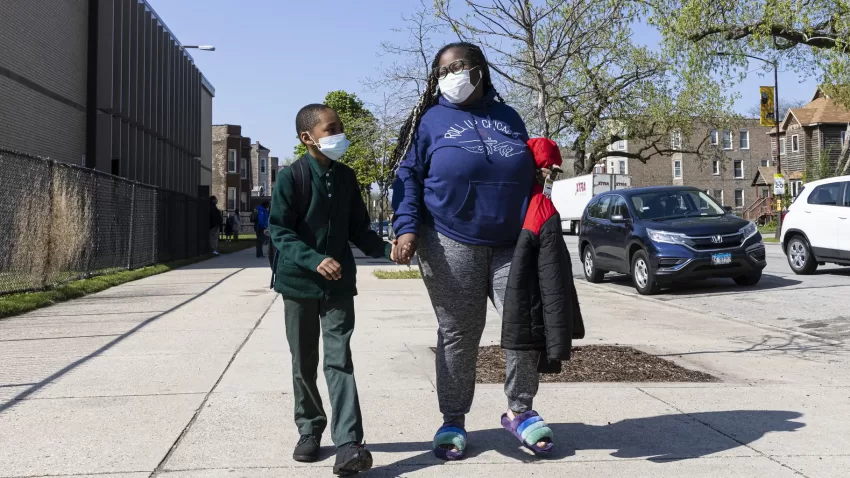
Move Past Whiteness in Covering Remote Learning
“People affected by news stories should find the reporting insightful,” Ray Salazar, a teacher and blogger, wrote Wednesday in The Grade, which “provides independent analysis of media coverage of education.”
“So it’s been disappointing that I’ve struggled to find insight or meaning or value in many news stories about how the pandemic affected teenagers in public high schools – especially in pieces written by white journalists. . . .”
Salazar also wrote, “Anecdotally, the high-school students I saw coping with the pandemic most effectively were the students who were used to dealing with struggle and change and the unpredictable.
“The students who worked before the pandemic, the students whose lives included struggle and discomfort, the students who knew life includes the unexpected — they were the ones whose stories need to be told. What sources of strength and motivation have they found? What support do they need in order to continue making progress in difficult circumstances? Their experiences hold insights into the problems we need to address, the inequality we need to resolve, the injustice we need to challenge.
“That’s why I was so glad to see this Chicago Sun-Times article that emphasizes how we move forward.. . . the reporting goes beyond summarizing the problems. As one of the experts quoted here stresses, ‘If you only focus on “learning loss,” what ends up happening is you kind of focus on the student and what their problem is and you don’t actually see those systemic issues and you don’t end up focusing on those things.”
“Education reporting fails to be insightful to the low-income Black and Brown students and families — and the educators who work with them — when all we hear about are the problems. . . .”
“Post-pandemic, we need education reporting that combats the ideals of whiteness so we can find solutions to help students understand that progress is more important than perfection and comparison. . . .”
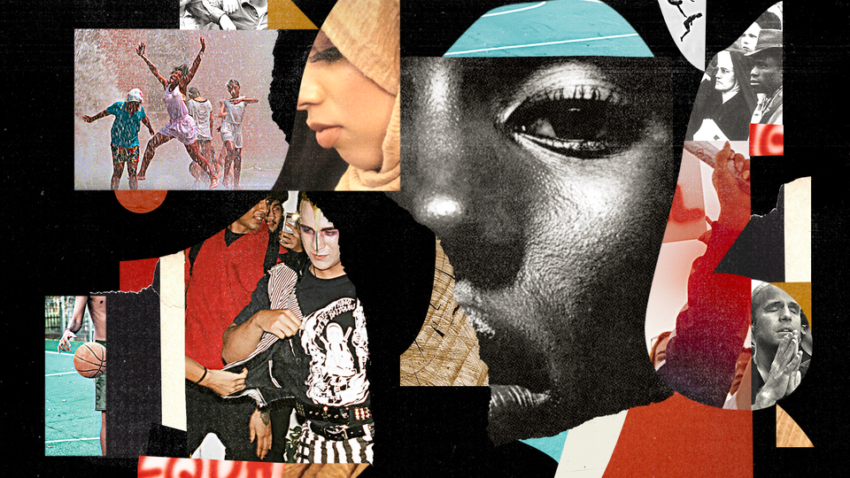
The Atlantic to Explore Myriad Ways to Be American
“Today, The Atlantic launches America In Person, a new section dedicated to exploring the complexity and multidimensionality of American identity,” the publication announced Monday.
“ ‘The Atlantic has long been preoccupied by pluralism and the American idea, so it’s only natural for us to explore in a dedicated way what it means to be American,’ said Jeffrey Goldberg, The Atlantic’s editor in chief. ‘American identity is far more layered, and far more interesting, than straightforward categorization allows.’
“Created as part of The Atlantic’s culture vertical, America In Person is led by senior editor Lauren N. Williams with senior editor Mathew Rodriguez. It will build on The Atlantic’s robust tradition of writing about race, class, and gender, and will offer a more expansive and layered view of how people form communities and come to see themselves and one another in the United States. . . .”
“America In Person” launches with “America’s Investing Boom Goes Far Beyond Reddit Bros” by Talmon Joseph Smith, “The Fastest-Growing Group of American Evangelicals” by Meaghan Winter, about Latinos, and “The Surprising Innovations of Pandemic-Era Sex” by Madison Moore.
“In addition to Rodriguez, who joined The Atlantic in May, recent hires include assistant editor Andrew Aoyama; visuals editor Jehan Jillani; designer Shannon Lin, who joined the experimental-storytelling team; copy editor Christina McCausland; crossword-puzzles editor Paolo Pasco; podcast producer Rebecca Rashid; associate photo editor Cédric Von Niederhäusern; and fact-checkers Susan Banta, Isabel Cristo, Sam Fentress, and Yvonne Kim,” the announcement said.
. . . There’s Also ‘Black Atlantic’ in Nigeria
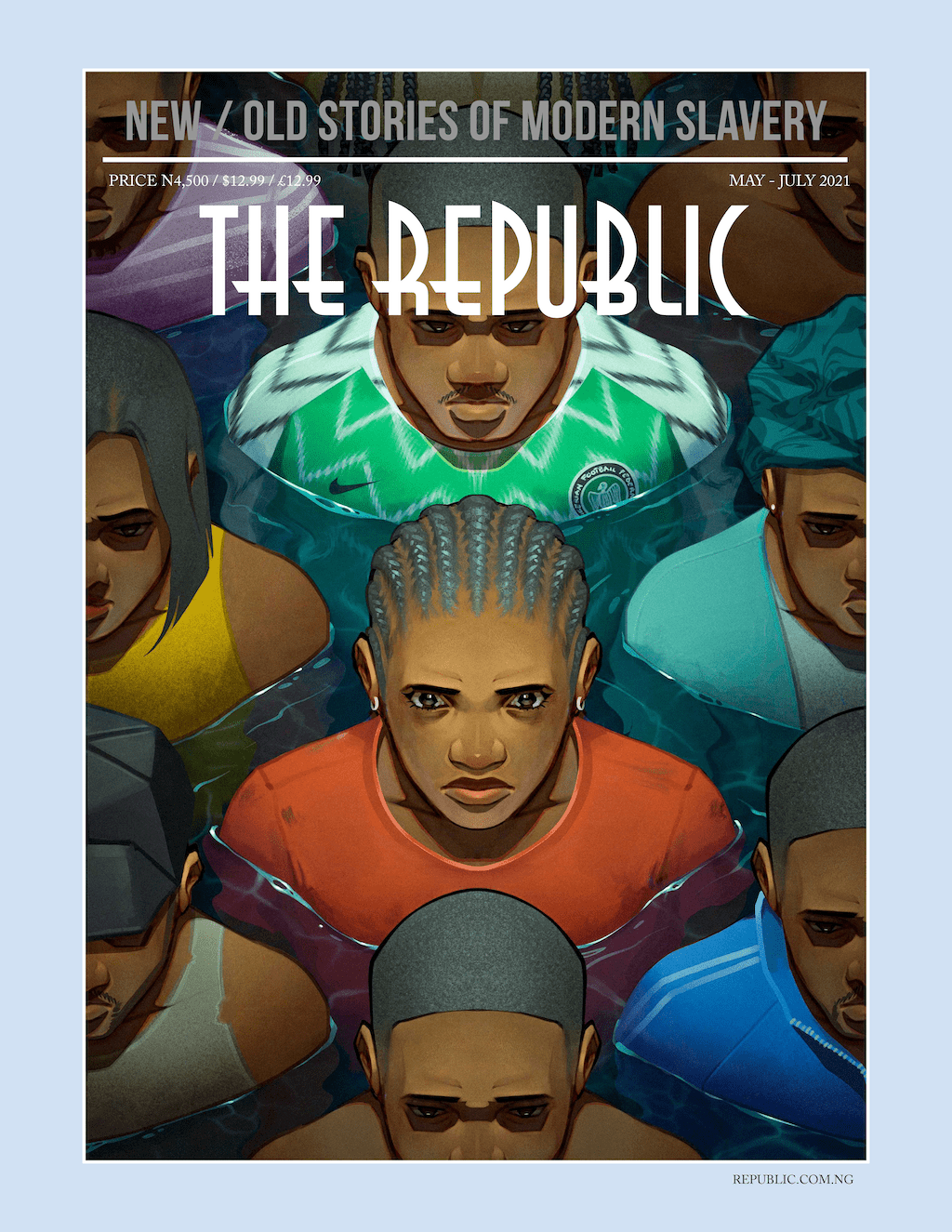 “The Black Atlantic is a new project at The Republic that showcases nuanced, human stories centered on blackness and Black identities from Africa and the African diaspora,” the Nigerian publication announced in April.
“The Black Atlantic is a new project at The Republic that showcases nuanced, human stories centered on blackness and Black identities from Africa and the African diaspora,” the Nigerian publication announced in April.
“Our editors are looking, first and foremost, for stories -— compelling, moving narratives from around the world on what it means to be Black today. We want to read personal essays about, essentially, everything Black — with an emphasis on food, personal history, relationships, travel (or migration) and sexuality. We expect such essays to revolve around a big life event (or decision) the writer is trying to unpack.
“Most importantly, we want original, true stories that are rooted in specific places and offer fresh voices and perspectives. . . .”
Short Takes
- “A counterterrorism organization formed by some of the biggest U.S. tech companies including Facebook (FB.O) and Microsoft (MSFT.O) is significantly expanding the types of extremist content shared between firms in a key database, aiming to crack down on material from white supremacists and far-right militias, the group told Reuters,” Elizabeth Culliford reported Monday for Reuters.
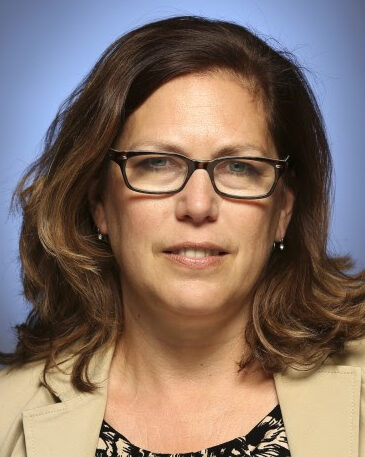 “Mariel Garza (pictured) is being promoted to deputy editorial page editor and will join The Times’ masthead, effective Aug. 9,” Sewell Chan, editorial page editor of the Los Angeles Times, reported Monday. “Since she joined the editorial board in 2015, Garza has distinguished herself with her clear writing, moral purpose and sound reasoning on the most pressing issues facing Californians. . . .”
“Mariel Garza (pictured) is being promoted to deputy editorial page editor and will join The Times’ masthead, effective Aug. 9,” Sewell Chan, editorial page editor of the Los Angeles Times, reported Monday. “Since she joined the editorial board in 2015, Garza has distinguished herself with her clear writing, moral purpose and sound reasoning on the most pressing issues facing Californians. . . .”
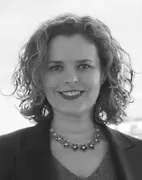 “NPR President and CEO John Lansing has promoted Isabel Lara (pictured) to be NPR’s first Chief Communications Officer,” the organization announced Tuesday. “Lara has led NPR’s media relations team and acted as the organization’s spokesperson since 2014, most recently as Executive Director for Media Relations. The CCO is a new senior executive role that elevates and focuses strategic oversight of NPR’s communications with all audiences, ensuring a unified and consistent voice and a strong representation of the NPR brand across channels. . . .”
“NPR President and CEO John Lansing has promoted Isabel Lara (pictured) to be NPR’s first Chief Communications Officer,” the organization announced Tuesday. “Lara has led NPR’s media relations team and acted as the organization’s spokesperson since 2014, most recently as Executive Director for Media Relations. The CCO is a new senior executive role that elevates and focuses strategic oversight of NPR’s communications with all audiences, ensuring a unified and consistent voice and a strong representation of the NPR brand across channels. . . .”
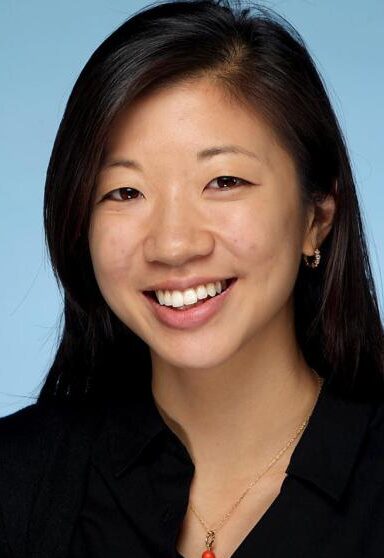 Alice Su (pictured) of the Los Angeles Times and Mathias Boelinger of Deutsche Welle were covering the aftermath of severe flooding in Zhengzhou, China, Saturday when a nationalist mob confronted them and accused them of “smearing China,” Helen Davidson reported Monday for The Guardian. Boelinger said he believes that the crowd mistook him for Robin Brant of the BBC, which has recently been the subject of a harassment campaign in China. “In the past 18 months at least 16 US journalists have been expelled, and at least four journalists – including the BBC’s John Sudworth and two Australian journalists – were forced to flee. Two others – Australian TV anchor Cheng Lei and Chinese Bloomberg journalist Haze Fan – were arrested and detained on undefined national security accusations.”
Alice Su (pictured) of the Los Angeles Times and Mathias Boelinger of Deutsche Welle were covering the aftermath of severe flooding in Zhengzhou, China, Saturday when a nationalist mob confronted them and accused them of “smearing China,” Helen Davidson reported Monday for The Guardian. Boelinger said he believes that the crowd mistook him for Robin Brant of the BBC, which has recently been the subject of a harassment campaign in China. “In the past 18 months at least 16 US journalists have been expelled, and at least four journalists – including the BBC’s John Sudworth and two Australian journalists – were forced to flee. Two others – Australian TV anchor Cheng Lei and Chinese Bloomberg journalist Haze Fan – were arrested and detained on undefined national security accusations.”
- “Tunisian police has stormed Al Jazeera’s bureau in the capital Tunis, expelling all the staff, after President Kais Saied late on Sunday ousted the government in a move his foes called a coup,” Al Jazeera reported Monday. “At least 20 plain-clothed police officers entered the office on Monday, Al Jazeera journalists in Tunis reported, saying the officers did not have warrants for the raid.”
What Journalists Can Learn From Bob Moses
July 26, 2021
Self-Effacing Civil Rights Organizer Dies at 86
NBC Brands Lester Holt ‘Anchor for America’
An Encounter That Went Viral
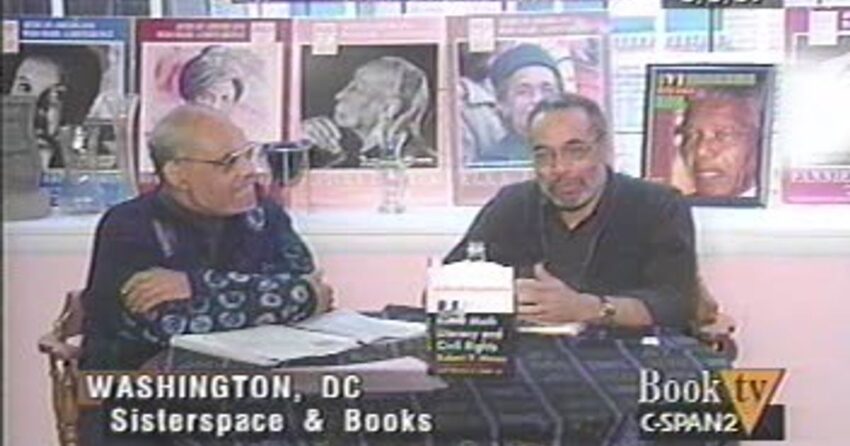
Self-Effacing Civil Rights Organizer Dies at 86
Charles E. Cobb Jr., a co-founder of the National Association of Black Journalists and a colleague of civil rights organizer Robert P. (Bob) Moses in the Student Nonviolent Coordinating Committee, was asked Sunday whether there were things to say about Moses that would connect him with journalism. Moses died that morning at 86.
Cobb’s response was brief. “I don’t really have anything to say in this vein . . . except perhaps to say how frequently the press ignores the work of a consequential life until it has passed,” the author, journalist and activist messaged Journal-isms.
Moses’ life, perhaps underreported but certainly consequential, carried lessons for journalists, particularly Black journalists.
Paul W. Valentine summed up that consequence in The Washington Post’s obituary. “Bob Moses, a towering but self-effacing leader of the civil rights movement who, after enduring beatings and jailings to register Black voters in Mississippi in the 1960s, picked up the civil rights torch 20 years later by founding the Algebra Project, a math education initiative aimed at rural and inner-city students, died July 25 at his home in Hollywood, Fla. He was 86. . . .”
Moses and Cobb wrote “Radical Equations: Math Literacy and Civil Rights” in 2001 about that Algebra Project.
In explaining the story of the book, Cobb wrote Journal-isms then that journalists need to understand that the civil rights movement was not just about the drama of marches and protests, but about organizing, a theme that Cobb would continue to stress in subsequent writings, such as “This Nonviolent Stuff′ll Get You Killed: How Guns Made the Civil Rights Movement Possible” in 2015.
Cobb also urged in his message that journalists read “Radical Equations” to help them take up the cause of schools serving African Americans that have been “written off.”
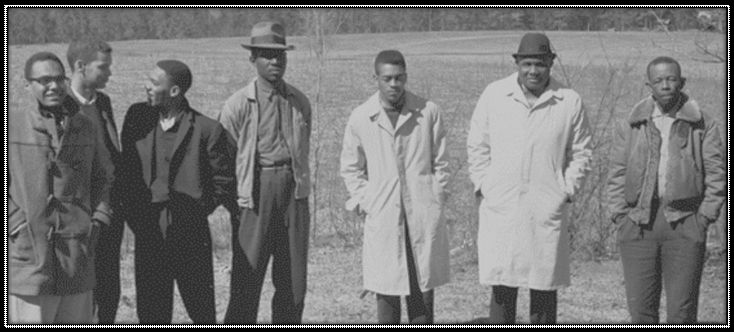
Cobb wrote Journal-isms:
“Bob Moses and I go way back, way back to the early summer of 1962 when as a 19-year-old I wandered into Mississippi and wound up being persuaded to stay by the young people we talk about in Part One of the book.
“I stayed in the state for almost five years as a SNCC field secretary. I have been a writer and journalist for the last quarter-century so it was easy and natural for Bob to turn to me for the telling of his story (my condition was that it had to be told in his voice) because trust as well as skill is necessary to work together in this kind of book-writing relationship.
“For me, telling Bob’s story was a way into beginning to write about the older organizing tradition of the Southern civil rights movement that we were pulled into as students engaged in sit-in protests against lunch counter segregation. I think this organizing tradition has largely been overlooked by historians, academics and journalists who seem to prefer the drama of marches and protests and excerpts from Dr. [Martin Luther] King’s ‘I Have a Dream’ speech.
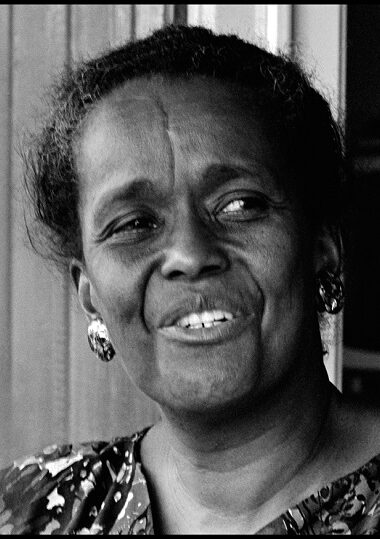 “I am committed to continuing to write about the Southern civil rights organizing of the 1960s. Part of what Bob and I agreed on early in the book project was that we wanted to bring the names and actions of at least some of the older people (Ella Baker [pictured], Amzie Moore, E.W. Steptoe, etc.) on whose shoulders we stood — many of them local NAACP leaders who for years, decades in most cases, had been fashioning what amounted to an underground guerrilla struggle — into focus. As we say in the book, they were our ‘fundis’ — teachers with whom we apprenticed — in the tradition of community organizing.
“I am committed to continuing to write about the Southern civil rights organizing of the 1960s. Part of what Bob and I agreed on early in the book project was that we wanted to bring the names and actions of at least some of the older people (Ella Baker [pictured], Amzie Moore, E.W. Steptoe, etc.) on whose shoulders we stood — many of them local NAACP leaders who for years, decades in most cases, had been fashioning what amounted to an underground guerrilla struggle — into focus. As we say in the book, they were our ‘fundis’ — teachers with whom we apprenticed — in the tradition of community organizing.
“Our discussion of the Algebra Project connects to this tradition and the broad argument we are raising with our discussion of math literacy is that public schools should educate instead of create sharecroppers.
“The Algebra Project is retooling the organizing tradition of the civil rights movement to advance an American tradition that argues for education as the fundamental structure for opportunity and meaningful citizenship.
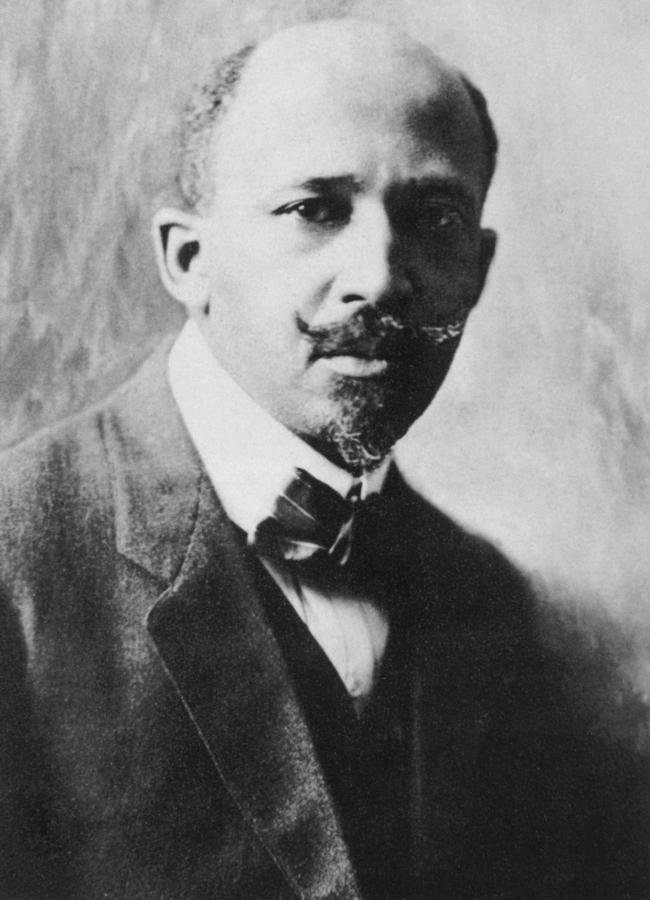 “No one understood this better than freed Negro slaves during and right after the Civil War. ‘The first great mass movement for public education at the expense of the state, in the South, came from Negroes. Public education for all at public expense, was, in the South, a Negro idea,’ wrote W.E.B. Du Bois (pictured) in ‘Black Reconstruction.’ With tragic consequences, the idea of quality education for each and every student in public school has been abandoned.
“No one understood this better than freed Negro slaves during and right after the Civil War. ‘The first great mass movement for public education at the expense of the state, in the South, came from Negroes. Public education for all at public expense, was, in the South, a Negro idea,’ wrote W.E.B. Du Bois (pictured) in ‘Black Reconstruction.’ With tragic consequences, the idea of quality education for each and every student in public school has been abandoned.
“And the whole discussion about ‘school reform’ underway now does not address fixing public schools that now amount to little more than sharecropper schools in inner cities and the rural South. Instead, they are still being written off.
“This is something for journalists — especially Black journalists — to probe using our book as one tool.”
- Ramtin Arablouei, Laine Kaplan-Levenson, Lawrence Wu, Julie Caine, Jamie York, Parth Shah, Victoria Whitley-Berry, “Throughline,” NPR: The Most Sacred Right (2020) (July 15)
- Charles M. Blow, New York Times: The Voter Fraud Fraud (July 11)
- Michael Levenson, Clay Risen and Eduardo Medina, New York Times: Bob Moses, Crusader for Civil Rights and Math Education, Dies at 86
- Courtland Milloy, Washington Post: Bob Moses saw math as the path to equality. School systems should build upon his work. (July 27)
- Nicolaus Mills, Daily Beast: Bob Moses Was the Quiet Architect of Mississippi’s Freedom Summer in 1964 (Jan. 23, 2015, updated Apr. 14, 2017)
- Lee O. Sanderlin, Mississippi Clarion Ledger: Bob Moses, Freedom Summer architect and civil rights leader, dead at 86
To subscribe at no cost, please send an email to journal-isms+subscribe@groups.io and say who you are.
Facebook users: “Like” “Richard Prince’s Journal-isms” on Facebook.
Follow Richard Prince on Twitter @princeeditor
Richard Prince’s Journal-isms originates from Washington. It began in print before most of us knew what the internet was, and it would like to be referred to as a “column.” Any views expressed in the column are those of the person or organization quoted and not those of any other entity. Send tips, comments and concerns to Richard Prince at journal-isms+owner@
View previous columns (after Feb. 13, 2016).
View previous columns (before Feb. 13, 2016)
- Diversity’s Greatest Hits, 2018 (Jan. 4, 2019)
- Book Notes: Is Taking a Knee Really All That? (Dec. 20, 2018)
- Book Notes: Challenging ’45’ and Proudly Telling the Story (Dec. 18, 2018)
- Book Notes: Get Down With the Legends! (Dec. 11, 2018)
- Journalist Richard Prince w/Joe Madison (Sirius XM, April 18, 2018) (podcast)
- Richard Prince (journalist) (Wikipedia entry)
- February 2018 Podcast: Richard “Dick” Prince on the need for newsroom diversity (Gabriel Greschler, Student Press Law Center, Feb. 26, 2018)
- Diversity’s Greatest Hits, 2017 — Where Will They Take Us in the Year Ahead?
- Book Notes: Best Sellers, Uncovered Treasures, Overlooked History (Dec. 19, 2017)
- An advocate for diversity in the media is still pressing for representation, (Courtland Milloy, Washington Post, Nov. 28, 2017)
- Morgan Global Journalism Review: Journal-isms Journeys On (Aug. 31, 2017)
- Diversity’s Greatest Hits, 2016
- Book Notes: 16 Writers Dish About ‘Chelle,’ the First Lady
- Book Notes: From Coretta to Barack, and in Search of the Godfather
- Journal-isms’ Richard Prince Wants Your Ideas (FishbowlDC, Feb. 26, 2016)
- “JOURNAL-ISMS” IS LATEST TO BEAR BRUNT OF INDUSTRY’S ECONOMIC WOES (Feb. 19, 2016)
- Richard Prince with Charlayne Hunter-Gault,“PBS NewsHour,” “What stagnant diversity means for America’s newsrooms” (Dec. 15, 2015)
- Book Notes: Journalists Follow Their Passions
- Book Notes: Journalists Who Rocked Their World
- Book Notes: Hands Up! Read This!
- Book Notes: New Cosby Bio Looks Like a Best-Seller
- Journo-diversity advocate turns attention to Ezra Klein project (Erik Wemple, Washington Post, March 5, 2014)
When you shop @AmazonSmile, Amazon will make a donation to Journal-Isms Inc. https://t.co/OFkE3Gu0eK
— Richard Prince (@princeeditor) March 16, 2018

